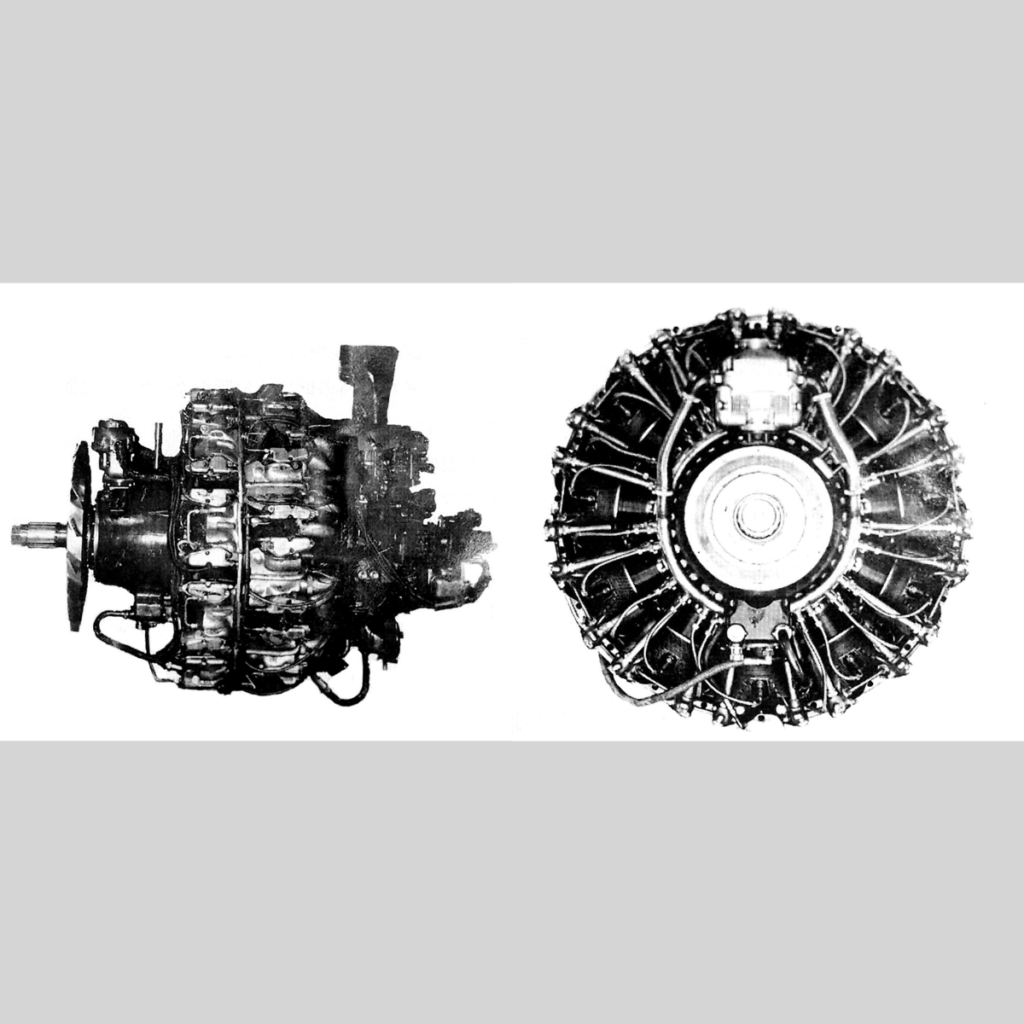
In December 1942, the Imperial Japanese Army (IJA) sought a new radial aircraft engine capable of more than 2,500 hp (1,864 kW). At the time, the most powerful Japanese production engines produced around 1,900 hp (1,417 kW). The new engine was given the IJA designation Ha-51 and was later assigned the joint Japanese Army and Navy designation [Ha-51]. However, the Imperial Japanese Navy did not show any interest in the engine.

The 22-cylinder Hitachi/Nakajima [Ha-51] engine had a general similarity to the Nakajima [Ha-45]. Note the cooling fan on the front of the engine and the dense nature of the cylinder positioning.
Some sources state that Nakajima was tasked to develop the new [Ha-51] engine, while other sources contend that Hitachi was in charge of the engine from the start. Both Nakajima and Hitachi had produced previous engines with the same bore and stroke as the [Ha-51]. However, the [Ha-51] shares some characteristics, such as fan-assisted air cooling, with other Nakajima engines. Regardless, development of the [Ha-51] was eventually centered at the Hitachi Aircraft Company (Hitachi Kikuki KK) plant in Tachikawa, near Tokyo, Japan. The Hitachi Aircraft Company was formed in 1939 when the Tokyo Gas & Electric Industry Company (Tokyo Gasu Denki Kogyo KK, or Gasuden for short) merged with the Hitachi Manufacturing Company.
The [Ha-51] was a 22-cylinder, two-row radial engine. Its configuration of 11-cylinders in each of two rows was only common with two other engines: the Mitsubishi A21 / Ha-50 and the Wright R-4090. Although the three engines were developed around the same time, it is not believed that any one influenced the others. Moving from nine cylinders in each row to 11 was a logical step for producing more power without increasing a radial engine’s length. The tradeoff was accepting the increased frontal area of the engine and additional strain on the crankpins.
The engine’s three-piece crankcase was made of steel and split vertically along the cylinder center line. The crankcase bolted together via internal fasteners located between the cylinder mounting pads. The cylinders consisted of an aluminum head screwed and shrunk onto a steel barrel. Each cylinder had one intake valve and one exhaust valve. The valves were inclined at a relatively narrow angle of around 62 degrees. The intake and exhaust ports for each cylinder faced the rear of the engine. The cylinders had a compression ratio of 6.8. The second row of cylinders was staggered behind the first row. Only a very narrow gap existed between the front cylinders to enable cooling air to the rear cylinders. Baffles were used to direct the flow of cooling air.

Drawing of the [Ha-51] with details of the cylinder intake and exhaust valves. The angle between the intake and exhaust valves was fairly narrow for a radial engine, a necessity to fit 11 cylinders around the engine while keeping its diameter as small as possible.
A single-stage, two-speed supercharger was mounted to the rear of the [Ha-51]. The supercharger’s impeller was 13 in (330 mm) in diameter and turned at 6.67 times crankshaft speed in low gear and 10.0 times crankshaft speed in high gear. Fuel was fed into the supercharger by a carburetor. At the front of the engine was a planetary gear reduction that used spur gears to turn the propeller at .42 times crankshaft speed. A cooling fan driven from the front of the gear reduction was intended to keep engine temperatures within limits once the [Ha-51] was installed in a close-fitting cowling.
The [Ha-51]’s fan-assisted cooling system was originally developed for the 1,900 hp (1,417 kW) Nakajima [Ha-45] Homare engine, which gives some credence to Nakajima being involved with the [Ha-51]. The [Ha-45] and the [Ha-51] also had the same bore and stroke. Nearly all Gasuden/Hitachi radial engines had a single row of nine-cylinders and produced no more than 500 hp (373 kW). Developing a two-row, 22-cylinder, 2,500 hp (1,864 kW) engine would be a significant jump for Hitachi, but much less so for Nakajima.
The [Ha-51] had a 5.12 in (130 mm) bore and a 5.91 in (150 mm) stroke. Its total displacement was 2,673 cu in (43.8 L). The engine had an initial rating of 2,450 hp (1,827 kW) at 3,000 rpm and 8.7 psi (.60 bar) of boost for takeoff, and 1,950 hp (1,454 kW) at 3,000 rpm with 7.7 psi (.53 bar) of boost at 26,247 ft (8,000 m). However, planned development would increase the [Ha-51]’s output up to 3,000 hp (2,237 kW). The engine was 49.4 in (1.26 m) in diameter, 78.7 in (2.00 m) long, and weighed 2,205 lb (1,000 kg).
Construction of the first [Ha-51] prototype was started in March 1944. Testing of the completed engine revealed high oil consumption and issues with bearing seizures between the crankpins and master rods. The gear reduction and cooling fan drive experienced failures, and difficulty with the supercharger led to broken impellers. Due to these issues, the engine was unable to pass a 100-hour endurance test. Three [Ha-51] engines and parts for a fourth had been built when the prototypes were damaged during a US bombing raid on the factory at Tachikawa in April 1945. Combined with the current state of the war, the setback caused by the air raid signaled the end of the [Ha-51] project. When US troops inspected the Tachikawa plant in late 1945, they found the three damaged and partially constructed [Ha-51] engines. One engine was mostly complete but lacked its supercharger section. Reportedly, this engine was reassembled by order of the US military, but no further information regarding its disposition has been found. All [Ha-51] engines were later scrapped, and no parts for them are known to exist.

Rear view of a [Ha-51] engine as found by US troops at Hitachi’s Tachikawa plant. The engine was fairly complete, with the exception of the supercharger and accessory section. This engine was reportedly reassembled at the request of the US military.